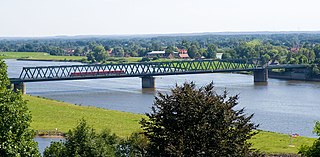The Lübeck–Lüneburg railway line is a 77 kilometre-long, single-track non-electrified rail link from Lübeck on the Baltic coast of the German state of Schleswig-Holstein to Lüneburg in Lower Saxony. The line was opened in sections between 1851 and 1864 and is one of the oldest railways in Germany.
| Lübeck–Lüneburg railway | |||||||||||||||||||||||||||||||||||||||||||||||||||||||||||||||||||||||||||||||||||||||||||||||||||||||||||||||||||||||||||||||||||||||||||||||||||||||||||||||||||||||||||||||||||||||||||||||||||||||||||||||||||||||||||||||||||||||||||||||||||||||||||||||||||||||||||||||||||||||||||||||||||||||||||||||||||||||||||||||||||||||||||||||||||||||||||||||||||||||||||||||||||||||||||||||||||||||||||||||
|---|---|---|---|---|---|---|---|---|---|---|---|---|---|---|---|---|---|---|---|---|---|---|---|---|---|---|---|---|---|---|---|---|---|---|---|---|---|---|---|---|---|---|---|---|---|---|---|---|---|---|---|---|---|---|---|---|---|---|---|---|---|---|---|---|---|---|---|---|---|---|---|---|---|---|---|---|---|---|---|---|---|---|---|---|---|---|---|---|---|---|---|---|---|---|---|---|---|---|---|---|---|---|---|---|---|---|---|---|---|---|---|---|---|---|---|---|---|---|---|---|---|---|---|---|---|---|---|---|---|---|---|---|---|---|---|---|---|---|---|---|---|---|---|---|---|---|---|---|---|---|---|---|---|---|---|---|---|---|---|---|---|---|---|---|---|---|---|---|---|---|---|---|---|---|---|---|---|---|---|---|---|---|---|---|---|---|---|---|---|---|---|---|---|---|---|---|---|---|---|---|---|---|---|---|---|---|---|---|---|---|---|---|---|---|---|---|---|---|---|---|---|---|---|---|---|---|---|---|---|---|---|---|---|---|---|---|---|---|---|---|---|---|---|---|---|---|---|---|---|---|---|---|---|---|---|---|---|---|---|---|---|---|---|---|---|---|---|---|---|---|---|---|---|---|---|---|---|---|---|---|---|---|---|---|---|---|---|---|---|---|---|---|---|---|---|---|---|---|---|---|---|---|---|---|---|---|---|---|---|---|---|---|---|---|---|---|---|---|---|---|---|---|---|---|---|---|---|---|---|---|---|---|---|---|---|---|---|---|---|---|---|---|---|---|---|---|---|---|---|---|---|---|---|---|---|---|---|---|---|---|---|---|---|---|---|---|---|---|---|---|---|---|---|---|---|---|---|---|---|---|---|---|---|---|---|---|---|---|---|---|---|---|---|---|---|---|---|---|---|
 | |||||||||||||||||||||||||||||||||||||||||||||||||||||||||||||||||||||||||||||||||||||||||||||||||||||||||||||||||||||||||||||||||||||||||||||||||||||||||||||||||||||||||||||||||||||||||||||||||||||||||||||||||||||||||||||||||||||||||||||||||||||||||||||||||||||||||||||||||||||||||||||||||||||||||||||||||||||||||||||||||||||||||||||||||||||||||||||||||||||||||||||||||||||||||||||||||||||||||||||||
| Overview | |||||||||||||||||||||||||||||||||||||||||||||||||||||||||||||||||||||||||||||||||||||||||||||||||||||||||||||||||||||||||||||||||||||||||||||||||||||||||||||||||||||||||||||||||||||||||||||||||||||||||||||||||||||||||||||||||||||||||||||||||||||||||||||||||||||||||||||||||||||||||||||||||||||||||||||||||||||||||||||||||||||||||||||||||||||||||||||||||||||||||||||||||||||||||||||||||||||||||||||||
| Line number |
| ||||||||||||||||||||||||||||||||||||||||||||||||||||||||||||||||||||||||||||||||||||||||||||||||||||||||||||||||||||||||||||||||||||||||||||||||||||||||||||||||||||||||||||||||||||||||||||||||||||||||||||||||||||||||||||||||||||||||||||||||||||||||||||||||||||||||||||||||||||||||||||||||||||||||||||||||||||||||||||||||||||||||||||||||||||||||||||||||||||||||||||||||||||||||||||||||||||||||||||||
| Locale | Schleswig-Holstein and Lower Saxony, Germany | ||||||||||||||||||||||||||||||||||||||||||||||||||||||||||||||||||||||||||||||||||||||||||||||||||||||||||||||||||||||||||||||||||||||||||||||||||||||||||||||||||||||||||||||||||||||||||||||||||||||||||||||||||||||||||||||||||||||||||||||||||||||||||||||||||||||||||||||||||||||||||||||||||||||||||||||||||||||||||||||||||||||||||||||||||||||||||||||||||||||||||||||||||||||||||||||||||||||||||||||
| Service | |||||||||||||||||||||||||||||||||||||||||||||||||||||||||||||||||||||||||||||||||||||||||||||||||||||||||||||||||||||||||||||||||||||||||||||||||||||||||||||||||||||||||||||||||||||||||||||||||||||||||||||||||||||||||||||||||||||||||||||||||||||||||||||||||||||||||||||||||||||||||||||||||||||||||||||||||||||||||||||||||||||||||||||||||||||||||||||||||||||||||||||||||||||||||||||||||||||||||||||||
| Route number | 145 | ||||||||||||||||||||||||||||||||||||||||||||||||||||||||||||||||||||||||||||||||||||||||||||||||||||||||||||||||||||||||||||||||||||||||||||||||||||||||||||||||||||||||||||||||||||||||||||||||||||||||||||||||||||||||||||||||||||||||||||||||||||||||||||||||||||||||||||||||||||||||||||||||||||||||||||||||||||||||||||||||||||||||||||||||||||||||||||||||||||||||||||||||||||||||||||||||||||||||||||||
| Technical | |||||||||||||||||||||||||||||||||||||||||||||||||||||||||||||||||||||||||||||||||||||||||||||||||||||||||||||||||||||||||||||||||||||||||||||||||||||||||||||||||||||||||||||||||||||||||||||||||||||||||||||||||||||||||||||||||||||||||||||||||||||||||||||||||||||||||||||||||||||||||||||||||||||||||||||||||||||||||||||||||||||||||||||||||||||||||||||||||||||||||||||||||||||||||||||||||||||||||||||||
| Line length | 77.3 km (48.0 mi) | ||||||||||||||||||||||||||||||||||||||||||||||||||||||||||||||||||||||||||||||||||||||||||||||||||||||||||||||||||||||||||||||||||||||||||||||||||||||||||||||||||||||||||||||||||||||||||||||||||||||||||||||||||||||||||||||||||||||||||||||||||||||||||||||||||||||||||||||||||||||||||||||||||||||||||||||||||||||||||||||||||||||||||||||||||||||||||||||||||||||||||||||||||||||||||||||||||||||||||||||
| Track gauge | 1,435 mm (4 ft 8+1⁄2 in) standard gauge | ||||||||||||||||||||||||||||||||||||||||||||||||||||||||||||||||||||||||||||||||||||||||||||||||||||||||||||||||||||||||||||||||||||||||||||||||||||||||||||||||||||||||||||||||||||||||||||||||||||||||||||||||||||||||||||||||||||||||||||||||||||||||||||||||||||||||||||||||||||||||||||||||||||||||||||||||||||||||||||||||||||||||||||||||||||||||||||||||||||||||||||||||||||||||||||||||||||||||||||||
| Operating speed | 120 km/h (74.6 mph) (maximum) | ||||||||||||||||||||||||||||||||||||||||||||||||||||||||||||||||||||||||||||||||||||||||||||||||||||||||||||||||||||||||||||||||||||||||||||||||||||||||||||||||||||||||||||||||||||||||||||||||||||||||||||||||||||||||||||||||||||||||||||||||||||||||||||||||||||||||||||||||||||||||||||||||||||||||||||||||||||||||||||||||||||||||||||||||||||||||||||||||||||||||||||||||||||||||||||||||||||||||||||||
| Maximum incline | < 2.0% | ||||||||||||||||||||||||||||||||||||||||||||||||||||||||||||||||||||||||||||||||||||||||||||||||||||||||||||||||||||||||||||||||||||||||||||||||||||||||||||||||||||||||||||||||||||||||||||||||||||||||||||||||||||||||||||||||||||||||||||||||||||||||||||||||||||||||||||||||||||||||||||||||||||||||||||||||||||||||||||||||||||||||||||||||||||||||||||||||||||||||||||||||||||||||||||||||||||||||||||||
| |||||||||||||||||||||||||||||||||||||||||||||||||||||||||||||||||||||||||||||||||||||||||||||||||||||||||||||||||||||||||||||||||||||||||||||||||||||||||||||||||||||||||||||||||||||||||||||||||||||||||||||||||||||||||||||||||||||||||||||||||||||||||||||||||||||||||||||||||||||||||||||||||||||||||||||||||||||||||||||||||||||||||||||||||||||||||||||||||||||||||||||||||||||||||||||||||||||||||||||||
Route
editThe line is a non-electrified main line that is equipped with GSM-R digital radio. The line has a speed limit of 120 km/h. The infrastructure-owner, DB Netze classifies the line as D4 class, permitting a maximum axle load of 22.5 tonnes and linear loads of 8.0 tonnes/metre.[2]
History
editThe Lübeck–Büchen section was opened in 1851 by the Lübeck-Büchen Railway Company (German: Lübeck-Büchener Eisenbahngesellschaft), after negotiations failed to agree on a direct connection between Lübeck and Hamburg through Holstein-Glückstadt, which was ruled by the King of Denmark. The section between Büchen and Lauenburg on the Elbe was built by the Berlin-Hamburg Railway Company and opened in 1851. In 1864 the Lauenburg–Hohnstorf train ferry was opened, establishing a connection to the Hanover rail network. The line was part of the shortest rail link from Hamburg to Hanover until the rail bridge over the Elbe in Hamburg was opened in 1872.
In 1865, the Lübeck-Büchen Railway Company, which retained its name, opened the direct Lübeck–Oldesloe–Hamburg line.
In 1878 an entirely iron bridge was built over the Elbe in Lauenburg, replacing the train ferry.
Until 1937, travellers from Lauenburg benefitted from the Lauenburg privilege (Lauenburger Privileg), allowing them to travel on the Berlin-Hamburg railway without having to pay for travel on the Lauenburg–Büchen section.
At the end of the 1980s several long-distance services on the bird flight line to Denmark used the Lübeck–Lüneburg line to bypass the Hamburg rail node.
A new station was opened at Lübeck-Hochschulstadtteil (the university district) northwest of Lübeck Airport in December 2013.[3]
Operations
editThe line has been served by Regionalbahn trains, operated by DB Regio, at an hourly frequency since December 2009, using class 648 diesel multiple units. Rates on the Ratzeburg–Lüneburg section are set by the Hamburg Transport Association (Hamburg Transport Association); rates on the Lübeck–Lauenburg section are set in accordance with the Schleswig-Holstein-Tarif. Little freight transport uses the route.
On 26 May 2008, a station was opened at Lübeck Airport (Lübeck-Flughafen). At the same time an electronic interlocking was established in Lübeck, replacing six old signal boxes in Pogeez, Ratzeburg, Mölln and Güster. In addition, another platform was built in Ratzeburg to enable train crossings. This meant that train could cross in Pogeez, Ratzeburg, Mölln, Büchen, Lauenburg and in Jäger operations station, north of Lüneburg.
Future
editIn the long term it is planned to operate services from Lübeck Airport and Ratzeburg to Lübeck at a half-hourly frequency.[4] In addition, the route will be electrified and double tracked to connect with the proposed Fehmarn Belt tunnel by about 2022. The line will then be used as a secondary route for freight trains. The main line will be the Lübeck–Hamburg railway.
See also
editReferences
editNotes
edit- ^ Eisenbahnatlas Deutschland (German railway atlas) (10 ed.). Schweers + Wall. 2017. pp. 12–3, 22, 118. ISBN 978-3-89494-146-8.
- ^ Eisenbahnatlas Deutschland (German railway atlas). Schweers + Wall. 2009. p. 170. ISBN 978-3-89494-139-0.
- ^ "Zwei neue Bahnhöfe für Lübeck". Lübecker Nachrichten (in German). 13 March 2013. Retrieved 25 April 2016.
- ^ Bahn-Report 1/2010, p. 39
References
edit- Krüger, Friedrich (1858). Die Verkehrsprotektion in Holstein und die direkte Lübeck-Hamburger Eisenbahn (in German). Hamburg.
{{cite book}}: CS1 maint: location missing publisher (link) - Gottwald, Alfred B. (1999). Die Lübeck-Büchener Eisenbahn (LBE) (in German). Düsseldorf. ISBN 3-87094-235-5.
{{cite book}}: CS1 maint: location missing publisher (link) - Wolff, Gerd (1972). Deutsche Klein- und Privatbahnen, Teil 1: Schleswig-Holstein/Hamburg (in German). Gifhorn. ISBN 3-921237-14-9.
{{cite book}}: CS1 maint: location missing publisher (link) - 125 Jahre Eisenbahn in Lübeck (in German) (Special Issue ed.). Verein Lübecker Verkehrsfreunde. October 1976.
- Otahal, Rüdiger (2002). Lübeck-Büchener Eisenbahn (in German). Munich. ISBN 3-7654-7130-5.
{{cite book}}: CS1 maint: location missing publisher (link) - Steinke, Lorenz (2006). Die Bedeutung der Lübeck-Büchener Eisenbahn für die Wirtschaft der Region Hamburg-Lübeck in den Jahren 1851 bis 1937 (in German). Lübeck. ISBN 3-7950-0483-7.
{{cite book}}: CS1 maint: location missing publisher (link) - Eisenbahnatlas Deutschland (German railway atlas) (2009/10 ed.). Schweers + Wall. 2009. ISBN 978-3-89494-139-0.